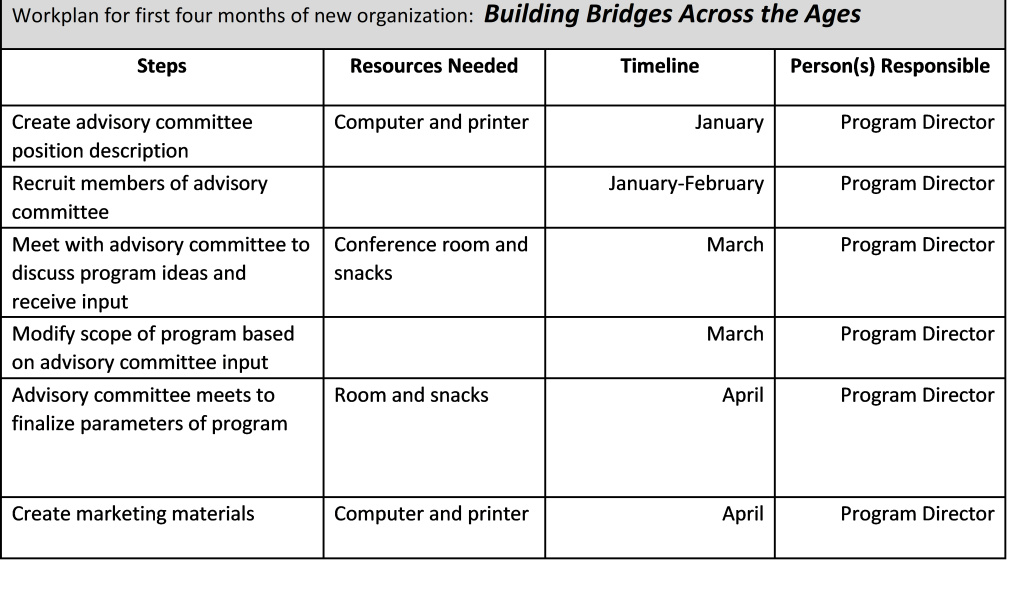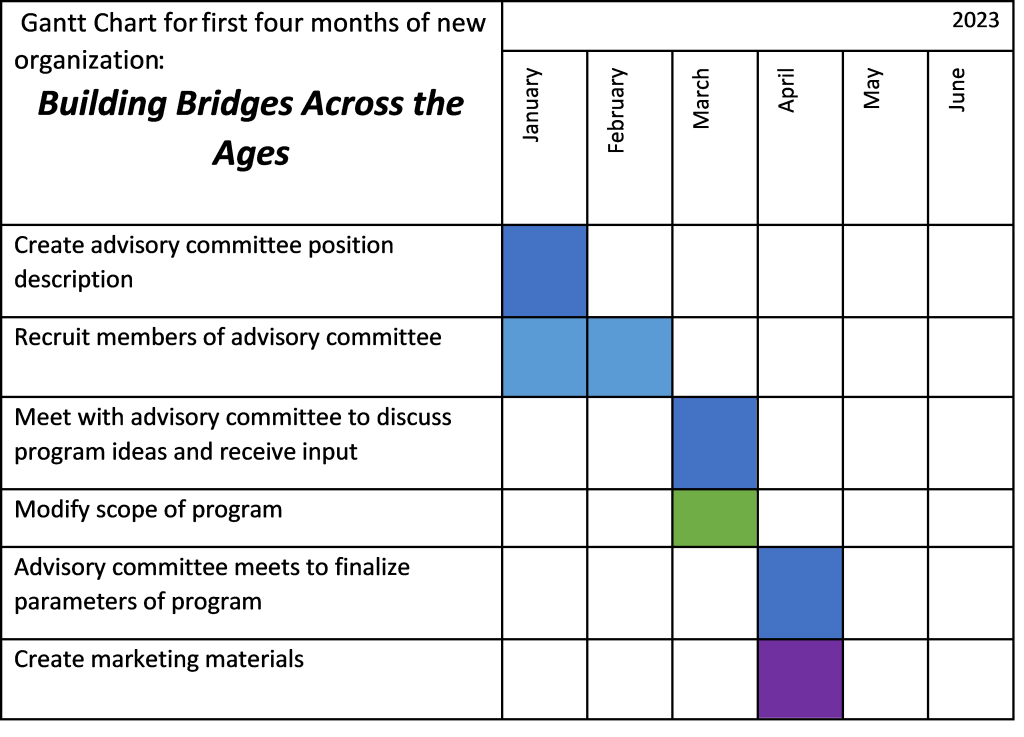30 Mapping the Work
“It feels like we are at a breaking point. Leaders know that more eyes are on them, much more pressure is on them, that they have to do something, they have to come up with some sort of solution. I want a concrete plan, not just nice words.”
Greta Thunberg, UNCOP24 Climate Summit
There are a few common styles of a work plan; each has a particular benefit to the type of community change strategy that has been selected. The creation of a work plan is a critical planning strategy; it establishes a list of specific steps that need to be taken and outlines the timeframe for implementation. An effective work plan becomes an invaluable tool for agency directors, staff, boards of directors, and funders because it communicates intention, thoughtfulness of the work, realistic timeframe, and measurable tasks.
This chapter focuses on two specific styles:
- Common Work Plan
- Gantt Chart
Common Work Plan
A common work plan includes specific information that establishes the steps and timeline for the implementation of a strategy or program. The work plan needs to be realistic and detailed enough to be useful. An effective work plan becomes an invaluable tool because it not only is a roadmap for implementation but is also used to build the organizational or project budget. The work plan is communicated in a spreadsheet-type format, usually using Microsoft Excel, Google Sheets, or Microsoft Word. The style of writing is abbreviated; without using complete sentences, the space needed to communicate the work plan is reduced, making it very easy to read.
The work plan includes:
- Specific steps for implementation
- If this is a new organization, the steps would need to include those necessary to create a new organization, including the development of a board of directors, filing articles of incorporation, etc.
- If the program is being implemented in an organization that already exists, then the timeline would be shorter and would likely include establishing an advisory committee, recruiting staff, training, etc.
- The timeline for each implementation step often focuses on a 12-month timeline
- Contacting people, scheduling meetings, recruiting and interviewing staff, and finding space for staff or services are all common steps in a work plan and require thoughtful timing so that the steps are listed in chronological order.
- If the work plan is for a community organizing initiative, you would likely want the timeline to reflect short-term goals and might prefer a 6-month timeline rather than a 12-month one.
- Resources that are needed to complete each step, focusing on those that require money, people, equipment, and space. Common types of resources include:
- Volunteers
- Space
- Food
- Supplies
- Partners
- Equipment
- Staff
- Trainers
- Person(s) responsible for each step.
- Be cautious about relying too much on the board of directors or advisory committee to complete the steps. Their role should be advisory and oversight, not day-to-day implementation work.
- The person responsible should be the person who would complete the task rather than the person(s) who would be consulted.

Gantt Chart
A Gantt chart is another type of work plan that visually communicates the steps, tasks, and timeline for the implementation of a strategy. It is formatted in a way that is easy to follow and track. [1] The visual nature of a Gantt chart helps outline how long the implementation is going to take and how the steps are distributed over time. Color is often used to differentiate the types of tasks or the person responsible. The example below provides a list of steps necessary for the first four months of a new program, Building Bridges Across the Ages, a mentoring and relationship program pairing elders with youth. The chart uses three colors to differentiate steps:
- Blue: Tasks related to an advisory committee
- Green: Tasks related to program planning and definition
- Purple: Tasks related to marketing

Establishing a clear and detailed work plan is a critical step that begins to identify not only the timeline for implementation but also the resources that are needed. The work plan needs to be realistic and detailed enough to be useful for staff, volunteers, the Board of Directors, and funders.
How to use the Work Plan
Work plans are intended to be dynamic and should be updated or modified as needed. Teams or groups working on implementing a project or program should refer to the work plan regularly, as well as track and communicate progress. For most projects, this is done every month.
A new work plan should also be created periodically, usually annually. Again, if you are creating a work plan for a community organizing initiative, you should look at the work plan regularly and update it frequently since your timeline would likely be much shorter than one year.
- Mind Tools (nd) Gantt charts: Planning and scheduling team projects. https://www.mindtools.com/pages/article/newPPM_03.htm ↵